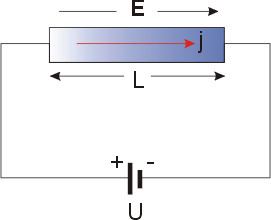 | ||
In physics, the Wiedemann–Franz law states that the ratio of the electronic contribution of the thermal conductivity (κ) to the electrical conductivity (σ) of a metal is proportional to the temperature (T).
Contents
Theoretically, the proportionality constant L, known as the Lorenz number, is equal to
This empirical law is named after Gustav Wiedemann and Rudolph Franz, who in 1853 reported that κ/σ has approximately the same value for different metals at the same temperature. The proportionality of κ/σ with temperature was discovered by Ludvig Lorenz in 1872.
Qualitatively, this relationship is based upon the fact that the heat and electrical transport both involve the free electrons in the metal.
The mathematical expression of the law can be derived as following. Electrical conduction of metals is a well-known phenomenon and is attributed to the free conduction electrons, which can be measured as sketched in the figure. The current density j is observed to be proportional to the applied electric field and follows Ohm's law where the prefactor is the specific electrical conductivity. Since the electric field and the current density are vectors Ohm's law is expressed here in bold face. The conductivity can in general be expressed as a tensor of the second rank (3×3 matrix). Here we restrict the discussion to isotropic, i.e. scalar conductivity. The specific resistivity is the inverse of the conductivity. Both parameters will be used in the following.
Drude (c. 1900) realized that the phenomenological description of conductivity can be formulated quite generally (electron-, ion-, heat- etc. conductivity). Although the phenomenological description is incorrect for conduction electrons, it can serve as a preliminary treatment.
The assumption is that the electrons move freely in the solid like in an ideal gas. The force applied to the electron by the electric field leads to an acceleration according to
This would lead, however, to a constant acceleration and, ultimately, to an infinite velocity. The further assumption therefore is that the electrons bump into obstacles (like defects or phonons) once in a while which limits their free flight. This establishes an average or drift velocity Vd. The drift velocity is related to the average scattering time as becomes evident from the following relations.
Temperature dependence
The value L0 = 2.44×10−8 W Ω K−2 results from the fact that at low temperatures (
Limitations of the theory
Experiments have shown that the value of L, while roughly constant, is not exactly the same for all materials. Kittel gives some values of L ranging from L = 2.23×10−8 W Ω K−2 for copper at 0 °C to L = 3.2×10−8 W Ω K−2 for tungsten at 100 °C. Rosenberg notes that the Wiedemann–Franz law is generally valid for high temperatures and for low (i.e., a few Kelvins) temperatures, but may not hold at intermediate temperatures.
In many high purity metals both the electrical and thermal conductivities rise as temperature is decreased. In certain materials (such as silver or aluminum) however, the value of L also may decrease with temperature. In the purest samples of silver and at very low temperatures, L can drop by as much as a factor of 10.
In degenerate semiconductors, the Lorenz number L has a strong dependency on certain system parameters: dimensionality, strength of interatomic interactions and Fermi-level. This law is not valid or the value of the Lorenz number can be reduced at least in following cases: manipulating electronic density of states, varying doping density and layer thickness in superlattices and materials with correlated carriers.
Violations
In 2011, N. Wakeham et al. found that the ratio of the thermal and electrical Hall conductivities in the metallic phase of quasi-one-dimensional Li0.9Mo6O17 diverges with decreasing temperature, reaching a value five orders of magnitude larger than that found in conventional metals obeying the Wiedemann–Franz law.
A Berkeley-led study in 2016 by Lee et al. also found a large violation of the Wiedemann–Franz law near the insulator-metal transition in VO2 nanobeams. In the metallic phase, the electronic contribution to thermal conductivity was much smaller than what would be expected from the Wiedemann–Franz law. The results can be explained in terms of independent propagation of charge and heat in a strongly correlated system.
